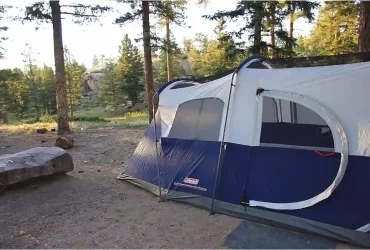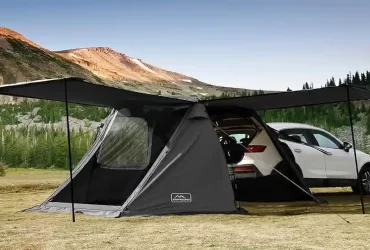Learn how to transform cold camping reservations into cozy winter retreats with our guide on how to camp in the snow. Perhaps you have wondered whether pitching a tent in the cold or during a snowstorm makes sense. This exhilarating experience is a must-have if you are prepared correctly.
Winter camping isn’t just about surviving the cold; it’s also about experiencing a magical world untouched by humans. There are no bugs, less foot traffic, and snow-covered landscapes make for a serene experience. Nevertheless, to actually make the most of this, you’ll need a little winter-specific knowledge.
Get ready for snow camping with the knowledge you’ve gained from sunny-day camping. The ability to stay warm and navigate snowy terrains require a great deal of experience. When it comes to weather, I’d recommend expecting the unexpected based on personal experience. Make sure that you are equipped, adapt to the weather, and let the crisp folds of the snow welcome you. Get the inside scoop on how to camp in the snow like a pro, and learn how to do it like a pro!
Why try Snow camping?

A winter camping trip is very different from a spring, summer, or fall camping trip. Many people have never experienced the silence of a deserted campsite, not just because of snow muffling its effects but also because there will be no other people there.
Snow swirls over rocks, softening the edges, and encasing limbs as they buck under their own weight, forming an elegant tunnel of light. Over the course of a season, snow makes a flat ground for you to set up your tent; there is no need to worry about finding a flat spot. You might see animal tracks crisscrossing the trail and campsite, and you may hear wings rushing through the trees. While it won’t be as busy as in the busier seasons, you will likely hear things you normally wouldn’t hear.
You may also like this:
How do you prepare for Snow camping?
You probably don’t think of spending an overnight in the snow when you think of winter activities. However, if you prepare correctly, winter camping does not have to be wet, miserable, or even too cold. This winter, the right gear, preparation of your site, and layering are key to staying safe and having a good time in the woods.
In addition to your existing gear system, a winter tent and a few other cold-weather items will make winter camping safer and more enjoyable. For those of you who are new to winter camping, or look to improve their four-season setup, we have some tips you should know.
What is the best tent for Snow camping?

In addition to buying a four-season tent, there are many options for repurposing a three-season tent. People generally use four-season tents during winter. The bulk and weight of these tents make them unsuitable for warmer climates, and will add unnecessary weight to your pack. Tents designed for winter are built with sturdier materials (such as heavier canvas) and have less mesh than tents designed for other seasons.
The shape of winter tents is often steeper and dome-shaped, which helps prevent snow loading and ensures better performance during adverse weather conditions. There is less mesh in winter tent bodies, and the fasteners are heftier, making arrangement easier while wearing bulky mittens. Once you reach your campsite, you’ll want to get out of the elements as fast as possible. The cold temperatures will make setting up your winter tent more challenging, so practice before you set out.
How do I keep a tent warm in the Snow?
Staying warm inside your tent is the most effective way to keep it warm in the winter. Obviously, you should stake the fly and guy it out as tight as you can to keep snow out. But staying warm is about the right layers and the right sleeping system. Buying a four-season tent can give you better protection from the elements, or you can make the most of a sturdy three-season tent for camping in winter.
How do I winterize a tent?
Winterizing a three-season tent won’t guarantee you a warm tent, and you can’t simply buy an insulated tent. Single-wall and double-wall tents can be found, but they will not be insulated. Winter camping with a three-season tent requires avoidance of models with flat tops, which place pressure on the poles and make the shelter ineffective at shedding snow. The snow stakes should be tightly packed around your normal tent stakes if you do not have snow stakes. For winter overnight camping, make sure to use all guy lines to prevent tent sagging and collapse.
How do I safely heat a tent?
There won’t be any inside heating to your tent, contrary to popular belief. In order to protect yourself from the elements, you will need to dig out a tent site. For a more stable tent space, pack down the snow that is just a few inches deep. Using a lightweight avalanche shovel is the best way to dig out your space in deeper snow. Ensure that your vestibule and the tent’s walls have enough space to allow for ventilation and prevent excess condensation.
How cold is too cold to camp?

If you’re thinking about four-season overnights instead of spring, summer, or fall, you need to keep a few things in mind. Temperature is one of the biggest factors. As long as your camping gear is adequate, you can camp in virtually any temperature. Depending on your sleeping bag’s temperature rating, you may need to supplement with a down jacket if you tend to sleep cold.
It is important to know what your sleep preferences are before choosing a sleeping bag. Although most people won’t like sleeping outside when the temperature drops below zero degrees Fahrenheit, it is still possible. Temperatures in the 30s at day with sunshine will feel wonderful, and with proper layering and gear, temperatures will drop down to single digits at night. Proper preparation, the right gear, and layers are all vital.
How do I layer for Snow camping?
In addition to a good sleep system, it is your clothing which keeps you warm and safe during the winter. Hike to your campsite in the smallest amount of clothing you can manage. Starting cold is okay-the less clothing you wear, the better. When you start to warm up, prepare to remove layers if you don’t want to start cold.
Dress in wicking tops and bottoms, and wear a midlayer or wind shell (depending on the weather). Generally, merino socks and ankle-high hiking boots will suffice, and insulated boots will be much more comfortable for your feet. In addition to wicking base layers, a fleece midlayer, and a down jacket, you’ll also want to bring a down jacket for warmth. Down protects raindrops from the down by providing a waterproof shell. Additionally, you can sit at camp without worrying about getting soaked with rain pants and waterproof shell pants. Layers such as wool socks, a beanie, and mittens complete the look.
You may also like this:
Cooking And Preparation

The performance of isobutane canisters in snow is lower than they are in other conditions. You can warm this type of fuel inside your sleeping bag or jacket pocket before using it on a snow trip if you rely on this type of fuel. When camping in cold temperatures, white fuel, such as that found in MSR WhisperLites, is much more effective. In addition, alcohol stoves perform well, however, they need to be paired with a windscreen and elevated.
Food planning can be challenging regardless of the weather. During the snow, convenience is your friend when you don’t want to remove your gloves. Make sure to pack easy-to-prepare, comforting meals, such as dehydrated meals. You can also find inexpensive meals such as mac and cheese, couscous, instant mashed potatoes, and soups that require only boiling water. It doesn’t take long for food to become cold in the snow. By using a deep bowl, you can reduce your food’s surface area and keep it piping hot!
Calories
Calories are constantly burned by our bodies to maintain a healthy body temperature. The temperature of our bodies is lower when we are cold, so we burn more calories. It is hard for our bodies to stay warm if we do not consume enough calories. Consider including calorically dense foods into your menu on a snow camping trip, and aim to consume between 3,000 and 5,000 calories per day. Your body needs that extra helping of Alfredo pasta, so go ahead and indulge!
Food For Sleep
Your body generates heat more slowly when proteins and fats are burned. Just before bed, eat a small amount of peanut butter or dried meat to keep yourself warm from within. A snack like this can be helpful if you awaken cold in bear country, as long as you are not in bear country.
Snack
Keep snacks in your bag throughout the day. In cold temperatures, you’ll burn more calories and stay warm by eating more calories. You will experience a burst of heat and energy after eating sugar, followed by a quick drop back to your normal body temperature. For fast energy, these types of snacks are ideal during the day. A snack with more fat and protein will stay with you for a longer period of time.
Hydration
Being well hydrated in the cold can be a challenge. It is possible to feel thirsty even if you are active. Drinking water regularly and frequently can prevent dehydration. You might want to warm up and hydrate with a hot tea in the morning and in the evening when it’s the coldest.
You may also like this:
How do I keep food from freezing during winter camping?
Food and water should not freeze during winter, so you can enjoy the outdoors. Ensure that your food does not freeze by planning ahead. Energy bars, peanut butter, and gel solidify into inedible bricks after eating them a few hours after eating. Keep energized during lunch or dinner by bringing hot meals and chocolate for a snack. During hiking and once you reach camp, make sure you keep your gels and energy bars close to you.
Melting snow for meals and drinking water will likely require extra fuel, so bring enough. Keep a water bottle and any snacks that may freeze inside your sleeping bag at night. The Sawyer Squeeze filter will become useless if it freezes, so include it with your sleeping bag.





Leave a Reply
View Comments